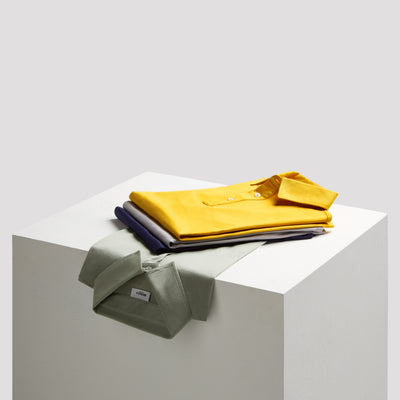Dressed for Success: What to Wear for Work in 2024?

The office work environment has evolved considerably in the last two decades: where before staid two and three-piece suits, starched collars and the double Windsor knot were the order of the day (together with Mad Men-style banter), now there are many acceptable ways for men to dress for success.
While it’s far too early to call time on the lounge suit as a staple of the classic office work wardrobe, there has been a distinct move over the last 10 years towards more informal dressing particularly for ‘casual Fridays’, days where there aren’t any client-facing meetings or during after-hours corporate entertainment events (within the limitations of the Bribery Act of course!). But a suit and tie combination has certainly had its day as the only marker of business respectability; there are now many accepted alternatives which fall under the 'business casual' umbrella.
This changing definition of ‘work clothes’ has, however, left many in a quandary about how to dress to maintain a professional image in the absence of sticking with a suit.
This changing definition of ‘work clothes’ has, however, left many in a quandary about how to dress to maintain a professional image in the absence of sticking with a suit (and let us not forget: whatever may be said about it, we can all agree that it made decisions about what to wear very simple – a quality navy suit with solid colour shirt and (optional) silk tie was a relatively easy formula to nail down).
So how can you make an impression in a world with fewer ground rules for what to wear at work?
Footwear
The right shoes are key to any great outfit: if ‘clothes maketh man’ then the work starts from the ground up. Since it is now acceptable for a man to own more than two pairs of shoes(!), there is no excuse for not having a variety in your wardrobe for different occasions. For semi-formal work use, we think the right pair of trainers are an excellent choice being breathable, comfortable and looking the part providing they aren’t a chunky trainer or anything similar. Aim for minimal logos, single dark colour leather or suede.
Trousers
We recommend a well-fitting pair of chinos or woollen trousers as an ideal base for a semi-formal outfit. Look for darker colours and a fit which is flattering to you - a 'straight' fit is ideal being neither too baggy nor too slim. Avoid the cream chinos plus light blue shirt combination so common in the US - it reeks of a complete lack of ideas. If wearing jeans, we suggest that darker colours are best and, needless to say, keep it conservative by avoiding on-trend, ripped or age-inappropriate styles.

Polo Shirts
The polo shirt is a staple of every man's weekend wardrobe but is increasingly a great option for semi-formal occasions providing the correct style is chosen. A ‘sports’ polo shirt, for example, is not compatible with business casual. Features of the typical sports polo include:
• a ‘tennis’ tail where the back of the shirt is 1-2cm longer than the front
• flat, knitted collars which have a strong tendency to curl
• large distracting logos – whether it's a reptile, a rodent or the 'King of the Jungle' you don’t wear them on your dress shirts, so why should you tolerate them on your polo shirts?
• lower quality fabrics which don't hold up to repeated wears as well as a structured polo shirt will; also, the colours fade more quickly
So, if you are going to wear a polo shirt while at work, then you should aim high - you want to make an impression, right? As such, we recommend a polo which has all or most of the features a high-quality shirt. This will mean allocating a similar budget, but you will own a polo which will look the part and will hang comfortably with your shirts in the closet rather than sit in a drawer with your t-shirts. Key features to look out for in a ‘work’ polo shirt include:
• long staple cotton material (such as Supima or Egyptian Mako or even Sea Island if your budget extends)
• stand collars which sit up properly allowing you to wear a light jacket or blazer with ease and preventing your neck from rubbing against the jacket’s collar (which inevitably leads to a sheen over time)
• genuine mother-of-pearl buttons
• no logos (or at most, a tonal, very discreet logo to chest or near the side vents)
• a reasonable fabric weight so no undershirt is required

Jacket
In the hotter summer months wearing a jacket can be a real burden particular on the journey to and from work. But what happens when that ‘surprise’ client meeting is sprung? We suggest leaving a light blazer in the office during hot spells as putting this on instantly elevates your style. And, providing you follow our advice on how to choose a high-quality polo shirt (particularly regarding a stand collar), you will have no difficulty pairing it and pulling off a more formal appearance instantly.
In conclusion, our top tips to dress for success in a semi-formal work environment are:
• Invest in yourself – with regular rotation and proper care, high quality clothing should last several years giving a far better return on your investment than lower quality brands
• Stick with solid colours – stay away from fancy prints or elaborate styles
• A polo shirt with a stand collar (as all Niccolò P. polo shirts have) is an excellent choice as they can be worn with a light jacket or blazer creating a very smart look that perfectly threads the line between formal and casual
And remember, as ever: first impressions last.
